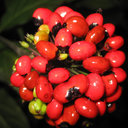Unigene-based RNA-seq provides insights on drought stress responses in Marsdenia tenacissima.
کلید واژه ها
خلاصه
Marsdenia tenacissima is a well-known anti-cancer medicinal plant used in traditional Chinese medicine, which often grows on the karst landform and the water conservation capacity of land is very poorly and drought occurrences frequently. We found M. tenacissima has strong drought resistance because of continuousdrought16 d, the leaves of M. tenacissima were fully curly and dying. But the leaves were fully almost recovering after re-watering 24h. The activity of SOD and POD were almost doubled under drought stress. The content of osmotic regulating substance proline and soluble sugar were three times than control group. But after re-watering, these indexes were declined rapidly. Three cDNA libraries of control, drought stress, and re-watering treatments were constructed. There were 43,129,228, 47,116,844, and 42,815,454 clean reads with Q20 values of 98.06, 98.04, and 97.88respectively.SRA accession number of raw data was PRJNA498187 on NCBI. A total of 8672, 6043, and 6537 differentially expressed genes (DEGs) were identified in control vs drought stress, control vs re-watering, and drought stress vs re-watering, respectively. In addition, 1039, 1016, and 980 transcription factors (TFs) were identified, respectively. Among them, 363, 267, and 299 TFs were identified as DEGs in drought stress, re-watering, and drought stress and re-watering, respectively. These differentially expressed TFs mainly belonged to the bHLH, bZIP, C2H2, ERF, MYB, MYB-related, and NAC families. A comparative analysis found that 1174 genes were up-regulated and 2344 were down-regulated under drought stress and this pattern was the opposite to that found after re-watering. Among the up-regulated genes, 64 genes were homologous to known functional genes that directly protect plants against drought stress. Furthermore, 44 protein kinases and 38 TFs with opposite expression patterns under drought stress and re-watering were identified, which are possibly candidate regulators for drought stress resistance in M. tenacissima. Our study is the first to characterize the M. tenacissima transcriptome in response to drought stress, and will serve as a useful resource for future studies on the functions of candidate protein kinases and TFs involved in M. tenacissima drought stress resistance.



